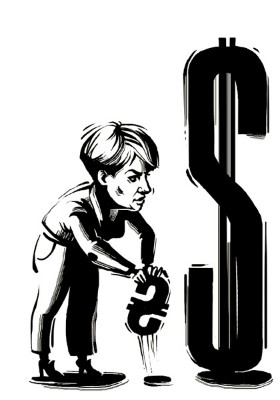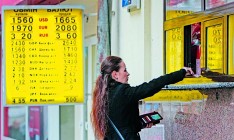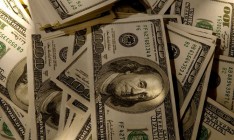Finance
currencyNBU postpones the introduction of market makers on the interbank exchange until better times

Following consultations with foreign experts the National Bank of Ukraine rejected the idea of introducing the concept of market makers on the Ukrainian interbank foreign exchange market. The members of the technical mission of the International Monetary Fund, who came to Kyiv upon the request of NBU Governor Valeriya Hontareva in mid-September, criticized her initiative. “They welcomed our idea of the introduction of market makers, but said we should do this later,” Hontareva told journalists. The central bank will continue to restrain hryvnia devaluation using its own forces.
Crisis of trust
The NBU announced the introduction of the concept of market makers on the interbank exchange early this fall. It was planned that the 15 largest commercial banks in Ukraine that have been most active on the currency market over the past three years would become market makers. They were expected to maintain the stability of trading volumes on the market using their own currency resources and access to currency interventions of the NBU that is exclusive only for them. The market makers were also expected to carry out the mission of restraining the exchange rate against excessive fluctuations, as they would be the only market players with the power to set two-sided quotations, specifically the rates for the purchase and sale of foreign currency. At that, the spread between these rates should have been extremely narrow, emphasized the NBU.
Hontareva explained the need for market makers by the sharp decrease in the liquidity of the interbank market. After introduction of the 0.5% duty on currency transactions to the Pension Fund in April, the trading volume on the interbank exchange dropped from US $1.2-1.3 bn in Q1 to US $0.2-0.3 bn.
In these conditions, even a small transaction at a rate different from the average market rate could have an impact on the market. Meanwhile, the NBU does not have enough of its own resources to support the market’s liquidity. By the beginning of October, its currency reserves amounted to only US $16.2 bn.
The IMF representatives, however, said such an initiative is premature. The obvious shortage of currency resources in commercial banks would be an obstacle for its realization. The earnings of exporters should be a source of currency proceeds, but, as a rule, they return to Ukraine only in case the funds are required to supporting a company’s operations. As a result, the regulator’s interventions remain the only source of hard currency for banks, complains the NBU governor. “All financial institutions are in the same position of going for interventions of the central bank, which is why at the moment we will not achieve the desired effect,” Hontareva stressed.
In addition to that, there are limitations of market makers to work with other banks on the market. Large financial institutions have limitations set for working with other, smaller players. This means that if a small bank, which is not within the limitations of the market maker, wishes to purchase currency from a large bank, it may not be able to do so and will be forced to re-purchase it from other banks. Moreover, such limitations exist even between the largest banks, which are expected to become market makers, says Hontareva. “We need our market makers to have a line set for all other banks, because only then will we have an overflow of hard currency resources on the market and not face a situation when only the largest banks manage to concentrate the flow of such resources internally and thereby attract all clients,” explained the head of the NBU.
NBU is left home alone
Despite the low level of gold and hard currency reserves, the NBU will still have to maintain the liquidity of the currency market all on its own. The IMF advises doing so through Dutch currency auctions. Since the beginning of autumn, Ukraine’s central bank held five auctions, the last one on October 2. “This method of sale of currency allows for tracing the use of funds and avoiding speculations,” Chief Financial Analyst at Expert-Rating Vitaliy Shapran assures. Hontareva says this method of interventions provides an opportunity to ensure currency supply for large importers and the cash counters of commercial banks. However, this is not the only instrument that the NBU plans to use. On October 6, the regulator sent a letter to the top managers of commercial banks informing that it plans to use two more instruments in addition to currency auctions in October-December. Traditional interventions at a single rate on the interbank is one of these instruments. Since the start of the year the net sale of currency by the NBU already reached US $4.6 bn, including US $735 mn in September. The regulator will continue to come onto the interbank exchange with the sale and purchase of currency in order to smooth out extreme fluctuations of the hryvnia rate. Now, this will be predictable every week. The NBU planned the next two interventions for October 9 and 10. On Thursday it plans to sell hard currency to replenish its cash counters at banks, which commercial banks should sell to individuals and use for repayment of hard currency deposits. On Friday, intervention will be executed for importers.
Direct intervention, which is a new concept for Ukraine, is the other instrument. The NBU explains that it will resort to this instrument only in case of urgent needs of national significance. Most likely, this is about the sale of hard currency for the state-owned corporations, believes Shapran. The NBU is applying this mechanism for work with Naftogaz Ukrainy, which purchased US $450 mn directly from the central bank. The analyst also believes that EnergoAtom, importers of oil product, coal and other critical importers may be eligible for direct interventions of the NBU.






 of the agreement of syndication with Financial Times Limited are strictly prohibited. Use of materials which refers to France-Presse, Reuters, Interfax-Ukraine, Ukrainian News, UNIAN agencies is strictly prohibited. Materials marked
of the agreement of syndication with Financial Times Limited are strictly prohibited. Use of materials which refers to France-Presse, Reuters, Interfax-Ukraine, Ukrainian News, UNIAN agencies is strictly prohibited. Materials marked  are published as advertisements.
are published as advertisements.